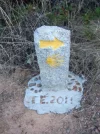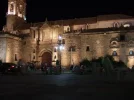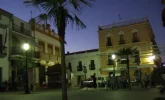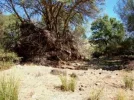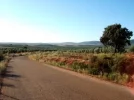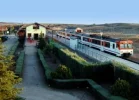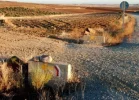bjorgts
Active Member
- Time of past OR future Camino
- In Spain, France, Portugal, Germany since 2003
We walked from Cordoba to Merida between 6.10 and 15.10 this year. The weather was warm and sunny. Eight out of ten days we had more than 30°C, and the evenings were just perfect for wet and frozen Norwegians. Almost no water running anywhere. Since people ask about this route, and not so many have written about it, I will give a “report” here, but the report will be made in parts.
We walked from Granada to Cordoba in Spring 2010, so we were familiar with the route. Now that we have walked it all, I think we can conclude that we found the part from Granada to Cordoba the nicest. But Cordoba – Merida is also well worth walking. Some parts are really nice. The Cordoba- friends have a guide on this address: http://www.caminomozarabe.es/index.php? ... e&Itemid=1, with maps and Spanish description. We used this one and the German guide from Outdoor (Conrad Stein Verlag) “Mozarabischer Jacobsweg”. With those two, we found our way.
There are not many walkers, but people told us that the top season is in spring. When we walked in spring we met some other walkers. October was definitively not top season. We did not see a single walker for our ten days. Several times people told us that there was a man a day ahead, so we understood there there was someone there. We were also told that he had told them that he had seen nobody all the way from Granada.
First day: Cordoba – Cerro Meriano, 18 km. We had some small problems fining our way out of Cordoba, but nothing that matters. The Cordoba- friends and the German guide are describing two different routs out of Cordoba. We followed the Cordoba-friends. The two routs are on each side of the main road N432. It seems both routs are marked. They meet after some kilometres when the one the German guide describes cross under the N432 to the east side of N432. We saw the yellow arrows pointing towards us in the tunnel. The rout the Cordoba-friends are describing, stayed on the east side all the way. The walk is quite steep up the last kilometres, so 18 km was enough for the first day with more than 30°C.
We followed the advice to do the walking this day without sacks and return to Cordoba when we reached Cerro Muriano. Cordoba is a very interesting city, and although we had been there in spring 2010, we wanted some more time there. So we had just enough time when we reached the village, to have a beer and a glass of cold Jugo de Naranjas natural (orangejuice) (perfect!) on the first restaurante, before we returned to Cordoba with the bus. You can find the Horarios here: http://www.caminomozarabe.es/images/sto ... 4d5401c997. The bus leaving Cerro Muriano 13:00 was perfect for us. There is a hostal in Cerro Muriano in the main street, so it is no problems staying there. We took the bus From Cordoba to Cerro Muriano next morning at 07:45.
Second day: Cerro Muriano – Villaharta, 21 km. The German guide promised us an “unspectacular day”, and in a way, that was right, because much of the day you walk parallel to the N432. But for long stretches we walked on paths a little bit away from N432, and then we think that we can not expect any better, when this main road is there after all. Half the way you can have a rest and visit a bar in El Vacar. (We had tomatos, queso and jamon! You are in jamon-land.) The lady at the bar/shop told us that she also had rooms for pilgrims.
Villaharta is a white, nice little village up in the hillside. There is a hostal which looked good (Bar Mirrasierra just when you enter the village), but the wife in the family was on hospital when we came there. When “mother” was not at work, the whole establishment was shut. There is a hostal down by the main road N432, El Cruce, so we stayed there. Next day (Villaharta – Alcarecejos) there is no way of splitting up the 38/39 km. For us that is just a too long distance, but how we solved that problem, I will tell you later. Bjørg
We walked from Granada to Cordoba in Spring 2010, so we were familiar with the route. Now that we have walked it all, I think we can conclude that we found the part from Granada to Cordoba the nicest. But Cordoba – Merida is also well worth walking. Some parts are really nice. The Cordoba- friends have a guide on this address: http://www.caminomozarabe.es/index.php? ... e&Itemid=1, with maps and Spanish description. We used this one and the German guide from Outdoor (Conrad Stein Verlag) “Mozarabischer Jacobsweg”. With those two, we found our way.
There are not many walkers, but people told us that the top season is in spring. When we walked in spring we met some other walkers. October was definitively not top season. We did not see a single walker for our ten days. Several times people told us that there was a man a day ahead, so we understood there there was someone there. We were also told that he had told them that he had seen nobody all the way from Granada.
First day: Cordoba – Cerro Meriano, 18 km. We had some small problems fining our way out of Cordoba, but nothing that matters. The Cordoba- friends and the German guide are describing two different routs out of Cordoba. We followed the Cordoba-friends. The two routs are on each side of the main road N432. It seems both routs are marked. They meet after some kilometres when the one the German guide describes cross under the N432 to the east side of N432. We saw the yellow arrows pointing towards us in the tunnel. The rout the Cordoba-friends are describing, stayed on the east side all the way. The walk is quite steep up the last kilometres, so 18 km was enough for the first day with more than 30°C.
We followed the advice to do the walking this day without sacks and return to Cordoba when we reached Cerro Muriano. Cordoba is a very interesting city, and although we had been there in spring 2010, we wanted some more time there. So we had just enough time when we reached the village, to have a beer and a glass of cold Jugo de Naranjas natural (orangejuice) (perfect!) on the first restaurante, before we returned to Cordoba with the bus. You can find the Horarios here: http://www.caminomozarabe.es/images/sto ... 4d5401c997. The bus leaving Cerro Muriano 13:00 was perfect for us. There is a hostal in Cerro Muriano in the main street, so it is no problems staying there. We took the bus From Cordoba to Cerro Muriano next morning at 07:45.
Second day: Cerro Muriano – Villaharta, 21 km. The German guide promised us an “unspectacular day”, and in a way, that was right, because much of the day you walk parallel to the N432. But for long stretches we walked on paths a little bit away from N432, and then we think that we can not expect any better, when this main road is there after all. Half the way you can have a rest and visit a bar in El Vacar. (We had tomatos, queso and jamon! You are in jamon-land.) The lady at the bar/shop told us that she also had rooms for pilgrims.
Villaharta is a white, nice little village up in the hillside. There is a hostal which looked good (Bar Mirrasierra just when you enter the village), but the wife in the family was on hospital when we came there. When “mother” was not at work, the whole establishment was shut. There is a hostal down by the main road N432, El Cruce, so we stayed there. Next day (Villaharta – Alcarecejos) there is no way of splitting up the 38/39 km. For us that is just a too long distance, but how we solved that problem, I will tell you later. Bjørg




